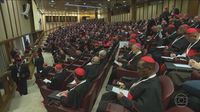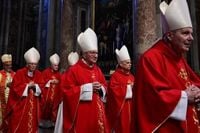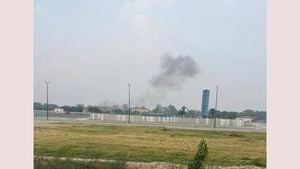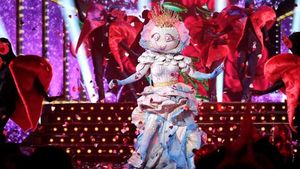The Vatican has confirmed that the 133 cardinals who will participate in the conclave to elect a new pope have arrived in Rome. The conclave, set to begin behind closed doors in the Sistine Chapel on Wednesday, May 7, 2025, will see all cardinals under 80 years old eligible to vote for the successor of Pope Francis, who passed away last month.
Since the death of Pope Francis on April 21, 2025, cardinals have been meeting almost daily to discuss the state of the Catholic Church, which has approximately 1.4 billion members worldwide. The Vatican reported that on Monday, May 5, 2025, a total of 180 cardinals, including 132 electors, participated in discussions regarding the future direction of the Church. The 133rd elector is also in Rome but did not take part in the discussions.
Two cardinals, one from Spain and another from Kenya, will not attend the conclave due to health issues, according to the Vatican. Among the topics addressed in Monday’s meeting was a "strong concern" regarding divisions within the Church, likely referencing disagreements over Pope Francis's decisions to allow blessings for same-sex couples and to open discussions about the role of women in the Church.
Cardinals also deliberated on the profile of a future pope, emphasizing the need for a figure who is "present, close, capable of being a bridge and a guide... a pastor close to the real lives of people," as stated by the Vatican spokesperson. With several cardinals emerging as potential candidates for the papacy, two names frequently mentioned are Cardinal Pietro Parolin from Italy and Cardinal Luis Antonio Tagle from the Philippines. However, many voting clerics have yet to finalize their choices. Cardinal Vincent Nichols, participating in his first conclave, remarked, "My list is changing, and I think it will continue to change in the coming days. It’s a process that, for me, is far from being concluded, very far from being concluded."
As the conclave approaches, speculation about the potential successors to Pope Francis has intensified. The College of Cardinals Report, compiled by Vatican journalist Edward Pentin and a team of specialists, identifies 12 cardinals as favorites to succeed Francis. The list predominantly features European candidates, with some representation from Asia and Africa, but notably lacks any South American contenders.
The favorites include:
- Anders Arborelius, 75, Bishop of Stockholm, Sweden, known for his dialogue skills and advocacy for divorced individuals, though he opposes female deacons.
- Charles Bo, 76, Archbishop of Rangoon, Myanmar, recognized for his strong stance on social justice and interfaith dialogue.
- Fridolin Ambongo Besungu, 65, Archbishop of Kinshasa, Democratic Republic of Congo, noted for his environmental activism and anti-colonial views.
- Jean-Marc Aveline, 66, Archbishop of Marseille, France, a favorite of Pope Francis for his defense of immigrants.
- Luis Antonio Tagle, 67, former Archbishop of Manila, Philippines, described as "Francis of Asia" for sharing the pope's vision on various issues.
- Malcolm Ranjith, 77, Archbishop of Colombo, Sri Lanka, a traditionalist who aligns with Francis on environmental issues.
- Matteo Maria Zuppi, 69, Cardinal of Rome and President of the Italian Episcopal Conference, known for his mediating role in international conflicts.
- Péter Erdő, 72, Archbishop of Budapest, Hungary, a conservative candidate advocating for pastoral care for remarried divorcees.
- Pierbattista Pizzaballa, 59, Latin Patriarch of Jerusalem, who has extensive knowledge of Middle Eastern issues.
- Pietro Parolin, 70, Secretary of State of the Holy See, often cited as a frontrunner due to his diplomatic experience.
- Robert Sarah, 79, a conservative voice within the Church, known for his opposition to same-sex blessings.
- Willem Eijk, 71, Archbishop of Utrecht, Netherlands, recognized for his solid orthodox positions.
The conclave will officially commence on Wednesday, May 7, 2025, starting with the votive mass Pro Eligendo Romano Pontifice at 5 AM (Brasília time) in St. Peter's Basilica. Following this, the cardinals will gather in the Paul VI Hall to pray and proceed to the Sistine Chapel, where they will take an oath of fidelity to the process and maintain absolute secrecy.
From May 8, the cardinals will vote four times a day—twice in the morning and twice in the afternoon. To elect a new pope, a two-thirds majority, or 89 votes, is required. If no candidate receives the necessary votes by Sunday, May 11, the process may be suspended for prayer and discussion. The conclave can last several days or even weeks, with the longest past conclave taking nearly three years.
The Vatican has already installed a chimney in the Sistine Chapel to signal the outcome of the votes; black smoke will indicate that the election is ongoing, while white smoke will announce the election of a new pope. As the Church prepares for this pivotal moment, the eyes of the world remain fixed on the Vatican, eager to see who will emerge as the next leader of the Catholic Church.





